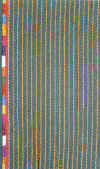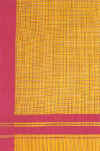|
|
|
||||
|
APRIL 2002 Contents
Travel 'Baikunth'
- the mountain Literature Visual Arts Jatin
Das - 4 decades of Music Zakir
Hussain - Compelling Hakim
Ajmal Khan's ancestral Business & Economy Performing Arts 'Fakir
of Benares' -1922 French Films Revathy
Menon's 'Mitr - my Books 'Knock
at Every Alien Door' People
Books
|
|
|
|||
| print gallery | |||||
|
Page 3 of 4
Textiles of Pakistan - Past & Present (cntd) by Shehnaz Ismail.
In 1612, the British established factories in Surat and later in Machilipatnam. The western part of the Indian subcontinent was famous for indigo dye. Indian indigo was used in Europe from the 16th century to mid 1900ís when artificial indigo dye was discovered. Until mid- 17th century, Indian textiles were mainly used for lining garments, but towards the end of the century, dresses and accessories of chintz became fashionable and for nearly a hundred years, Indian textiles dominated British trade. Traditional Indian patterns [the "Paisley" or the Mango motif] were adapted for European tastes. The flow of calico began to undermine the silk and wool industries in Europe and the manufacturers forced a virtual ban on Indian cotton. The subsequent high export duties on Calico eventually killed the industry in India, which was then forced to import goods from Manchester. The wealth accumulated from trade with India, enabled the British to bring about the Industrial revolution in the 18th century. First the Jacquard looms and then the mechanized roller printing mills of Manchester altered the trade pattern with the East forever. Industrial production cast a shadow over the vast technical and artistic achievements of textile weavers, but the English-speaking world still has not forgotten calico, pajama, dungaree, chintz, and khaki, the Indian textile terms exported to Europe with the textiles. In 1733, John Key invented the shuttle, which gave British manufacturers the edge they needed, to the importance of ever-popular chintzes from India, In 1783, the invention of roller-printing machine changed the industry forever. India, master dyer to the world was to see this craft vanish in less than a century. London, Manchester, and Lancashire grew into enormous manufacturing centers supplying the subcontinent. The subcontinent became the source of raw cotton for Lancashireís mills and Indian produced goods were prohibitively taxed. Cheap, machine made, mass produced textiles from England were forced upon every market and found their way to every village, destroyed the artisan and his craft, reducing him to unprecedented poverty. To quote Lord Bentick, " The bones of cotton weavers are bleaching the plains of India". In the mid 19th century Indian capitalists set up their own mechanized textile factories. Although Indian goods were heavily taxed by the British, a movement to buy Indian was initiated by nationalist forces and Gandhi started the swadeshi movement urging the use of homespun garments and a boycott of foreign textiles. This struck a crippling blow to England. Independence from the British in 1947 and the division of the Indian subcontinent into Pakistan and India started a new era for textiles production. Pakistan consisted of two entities, east and West Pakistan. The West was the cotton producing area and the East was responsible for jute production. At the time of partition, Pakistan had no industrial base and inherited only one textile mill, the Lyallpur Cotton Mill in Lyallpur [now called Faisalabad]. This mill produced yarn and gray cloth and no printed fabrics. Under the Open General Licensing [OGL] scheme, the business community imported plants and machinery with cash dollars. In 1950, Adamjee Mils was set up in Karachi, Kohinoor in Faisalabad, Colony Textile Mills in Multan, Nishat and Crescent Textile in Faisalabad. These were followed by Gul Ahmed Textile Mills, Al-Karam, Valika, Star and Rashid textile mills. Within a decade the new country of Pakistan was self-sufficient in cotton and began exporting gray cloth and later cotton yarn. Pakistan started exporting printed fabrics in the late 1970ís to Africa and by mid 80ís was sending printed material to Europe. Pakistanís location was ideal, as it lay halfway between the western world and the Far East. Pakistan has a 28 percent share in world export of cotton yarn and a 6 percent share in world export of cotton cloth.
|
|||||
| Copyright © 2000 [the-south-asian.com]. Intellectual Property. All rights reserved. | |||||
| Home | |||||



